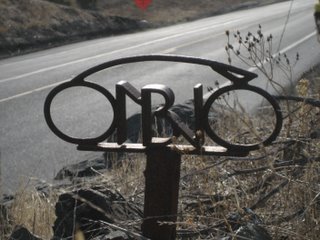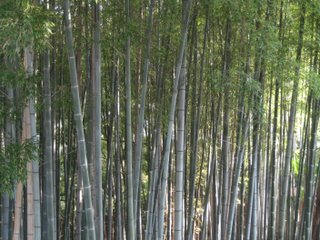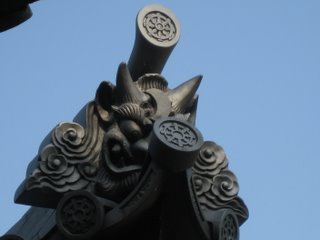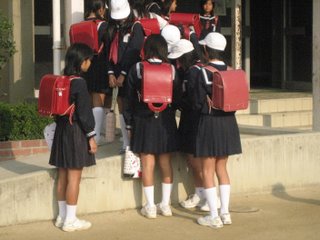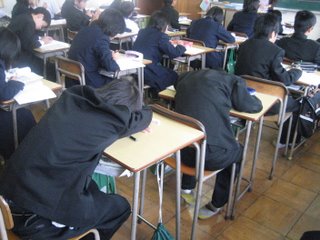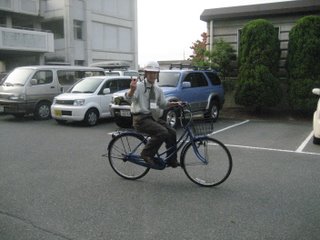Today I met my home stay "family," Mr. & Mrs. Hara, or Hara san, & Sachiko. They are a very kind couple, and in fact Mr. Hara had already called me twice at my hotel.
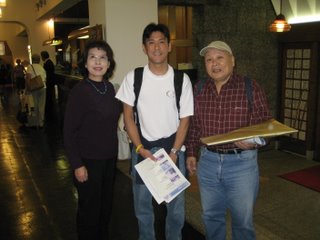
Mr. Hara & I went to Hiroshima for the day, while Mrs. Hara stayed at home. When we arrived in Hiroshima we met Hara san's brother and his friends for lunch at "Tosho." The food was delicious: a salad with dikon (Japanese radish), sake (smoked salmon), age dashi tofu (fried tofu), chawa mushi (fish flavored custard), and a type of sukiyaki with a curry broth which was a little on the hot & spicy side, Japanese brown rice, and a mango flavored something (sorry, no name).
After lunch we hailed a cab and went to the Peace Park Memorial. I made this trip a priority because part of my follow-up plan is to create lessons that promote peace and tolerance amongst my students, and the La Entrada School community. The Peace Park was created in the spirit of peace, and after reading Sadako and the Thousand Paper Cranes, by Eleanor Coerr, I knew that I had to make this part of my trip to Japan.
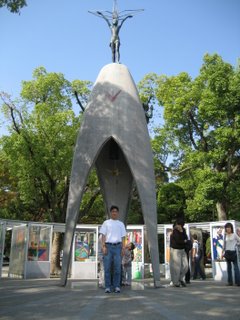
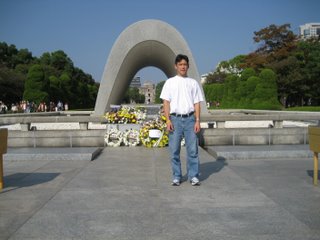
Here I am standing in front of the Peace Park Memorial Arch, behind me, in the distance, you can see the structure known as the Atomic Dome.
And lastly, here I am standing in front of the dome. Mr. Hara had taken a short break and was watching some musical performance, so I had this little Japanese tourist to take my picture. She quickly snapped my picture and then walked off to rejoin her group, only to turn around and walk up to me, and she said to me two words in her best English. “Hope. Peace.” I have no idea how she knew I was American, because I spoke to her in Japanese. Nevertheless, the fact that she turned around and came back to me to utter those two words was priceless.
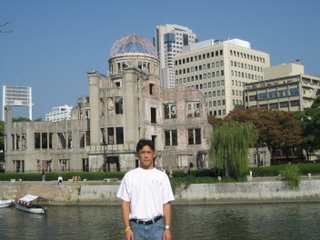
After Mr. Hara and I left the Peace Park, we went to find the city’s central library. Can you believe we had to ask at least ten people before anyone could tell us the location of the library? What’s that all about?
Anyway, we needed to find the library because we hoped that someone would be able to help us find the location of my great grandfather’s temple. I had two documents with information about my great grandfather, but no address or any real specific information.
The librarian who helped us was so patient. She spent over an hour with us looking over the documents, and she was able to locate a map that had obviously browned over time, because it looked really old. She then used a current map and was able to match locations from the old map to the current map. Apparently, my great grandfather’s town has since been associated with a new town and subsequently the name had changed. However, our librarian friend’s efforts paid off because she was able to locate five temples in the area she had pinpointed as the location where my great grandfather had supposedly lived.
At this point it was already close to five o’clock in the afternoon, and there is no daylight saving time in Japan, so the sun was about to set, literally and perhaps even metaphorically, so I thought. Nevertheless, Hara san and I hailed a cab and we set off on an incredible journey to the five temples. The taxi driver had to study the map quite carefully before he even started to drive and then he told us that it was about a forty-five minute drive. “Daijyobu! Haiyaku, ikimashou!” (No problem! Hurry up, let’s go!) I screamed.
This story just keeps getting better and better. EVERYONE that became involved in my quest also became entwined in the intrigue of the whole saga. The taxi driver offered to stay with us while we went from temple to temple. He was so incredibly dedicated and patient. We drove for quite sometime and eventually reached the foothills of an area near some river.
The first temple we reached was enormous, and the pastor’s family was outside playing. There was a graveyard off to the side, which got my hopes up. However the pastor’s wife said that it was the wrong temple but to try the next one over, which was literally right next-door. My hopes were dashed.
Let me cut to the chase a bit. We had no luck at the next three temples. At this point my hopes were gone. But, at the last temple, the pastor recognized the name and other information on the documents. He was not sure if his was the correct temple. He made a phone call and then returned and told us he would take us to a person who thought had met my grandmother, a certain Mr. Sasahara. Look familiar?
Well, the pastor lead our taxi driver to the house of Mr. Sasahara. He was a tiny old man. His wife was very kind and she looked at the documents and immediately began making phone calls, mind you it’s about 7 p.m. and pitch black at this point. After about an hour of talking, and talking, and talking, and more talking, all in Japanese mind you, I began to give up hope yet again. Then the Mrs. Sasahara said she contacted a man, Mr. Komoto, who remembered my grandmother coming to visit in the 1970s. However he lived in the mountains and was very old and could not come out at night.
At that point Hara san said that perhaps I would have to wait until the next time I came to Japan. My heart sank. Then there was more talking, in Japanese of course. I asked Hara san to ask the Sasaharas how far it was to Mr. Komoto’s house. When we realized that it was not far away, we offered to have our taxi driver take us there. Yes, Mr. taxi driver was still with us, a solid two hours into our mission. My hopes were restored.
We drove for about five minutes, further up the hill down these narrow ribbons of “road.” When we arrived at Mr. Komoto’s house, there was more talk in Japanese. Then he told us that he had been taking care of my great grandfather’s grave! My heart skipped a beat. Was it true? I jumped up and told Hara san to tell him to take us there! So, all four of us climbed into he cab. We drove another five minutes and when we rounded a turn I saw a school to my right, and on the upside of the hill, a cemetary. In Japan, most of the cemeteries are on hillsides, due to the limited amount of land.
We had arrived! In the pitch black Mr. Komoto lead us up some very steep steps. Keep in mind that Hara san is seventy years old and has been on the go with me all day. Both Mr. Komoto, and Mr. Sasahara were about eighty-five years old, and here we were hiking up the steps and dirt paths in pitch darkness, with nothing but a tiny flashlight to guide our way. It was totally surreal because there was an autumn festival taking place in the valley below, so all the while we were at the cemetery, you could hear taiko drumming, shakohachi (Japanese flute), and singing off in the distance.
What happened in the next five minutes I will remember for the rest of my life. Here is the result of many people coming together to help me connect with my ancestors.
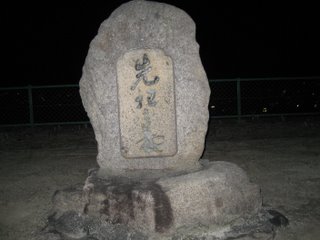
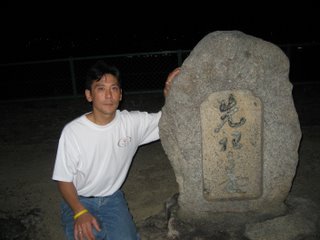
This is my great grandfather's grave. It dates back to the year 1886. It survived the Hiroshima atomic bombing. The inscription reads "Our ancestor's grave."
This tall gravestone was erected after WWII, and the inscription on the middle portion reads, "Sasagawa family." It is a communal gravestone for the Sasagawa family.
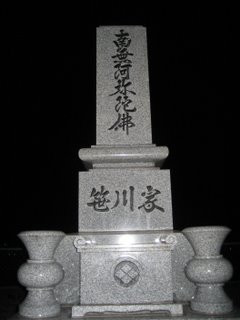
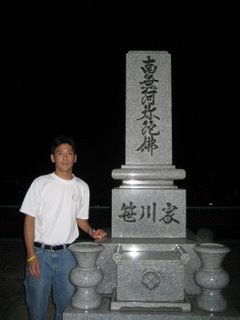
The image below is my family crest. This is exactly what I was looking for, but what I found was so much more.
The image below is the Komoto family crest. Mr. Komoto's family graves are right next to the Sasagawa family graves.
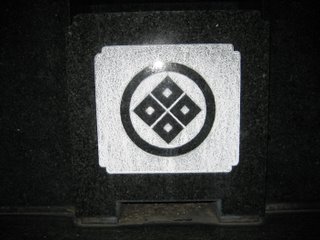
I owe a lifetime of gratitude to all of the people who came together and made this great moment possible: the librarian, Mr. taxi driver, Hara san, all the various people at the temples, and oh, by the way, Mr. Sasahara, and Mr. Komoto; they are my great grandfather's relatives, which makes them my relatives.
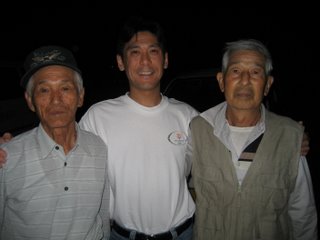
Mr. Komoto, me, and Mr. Sasahara
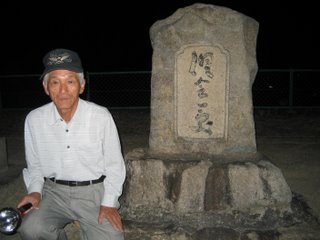
Mr. Komoto, the man responsible for taking care of my great grandfather's grave, kneeling infront of the Sasagawa family grave
This experience, in a word, AMAZING!
Update, eight years coming, September, 17, 2014.
In March, 2010, I returned to Takatori, Hiroshima, Japan, this time with my entire family, including my wife whom I met in Tokyo, while on my Fulbright Fellowship.
The first of the two photos below show my mother, Komoto-san, & my father, standing behind my great-grandfather's grave. This was the first time my father had seen his grandfather's grave. It was my honor & privledge to introduce my father to Komoto-san, & to his grandfather.
This last image is a picture of my father, Komoto-san, & me. This trip to Takatori was yet another trip to Hiroshima that I will never forget.
